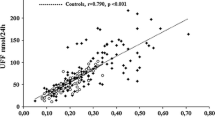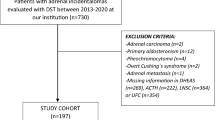Abstract
To evaluate whether low DHEA-S levels are predictors of cortical origin, benignity and hormonal activity in incidentally detected adrenal masses, thirty-five patients with adrenal incidentalomas were studied. All patients were operated on and the diagnosis was histologically confirmed. Basal endocrine workup included plasma determination of cortisol before and after dexamethasone (1 mg overnight), plasma ACTH (08:00 h), 17-OH-progesterone, testosterone and potassium, standing plasma renin activity and aldosterone, supine and standing plasma noradrenaline and adrenaline. If necessary, we performed dexamethasone suppression tests at low (2 mg) and high (8 mg) doses, or the loperamide test (16 mg os) for evaluation of glucocorticoid activity and the glucagon test (1 mg iv) for exploring adrenal medulla function. Plasma DHEA-S was measured in all patients and the results were compared to those obtained in controls matched for age, sex and menopausal status. Suppression of DHEA-S was found in 11 out of 35 patients (31.5%). However, this hormonal finding occurred in 50% of the extracortical adrenal lesions, while in proven cortical adenomas (no.=19) it was detected in only 5 patients (26.3%). Sensitivity, specificity, diagnostic accuracy and positive predictive value of low DHEA-S in indicating a cortical origin of the mass were 0.27, 0.0, 0.25, and 0.80. In malignancies (no.=6) low DHEA-S levels were found in 1 out of 2 metastases and never in cortical carcinomas. Sensitivity, specificity, diagnostic accuracy and positive predictive value of low DHEA-S in indicating a benign form were 0.34, 0.83, 0.42, and 0.91. Six out of 19 patients with cortical adenomas showed signs of hypothalamic-pituitary adrenal (HPA)-axis dysfunction. Low DHEA-S levels were found in 50% of adenomas with HPA-axis abnormality and in 15.3% of adenomas without hormonal activity. Sensitivity, specificity, diagnostic accuracy, and positive predictive value of low DHEA-S levels in indicating hormonal activity of the mass were 0.50, 0.84, 0.73, and 0.60. Our data indicate that the association between low DHEA-S levels and adrenal incidentalomas is frequent. Low DHEA-S appears to be a poor predictor of hormonal activity with low sensitivity and specificity in respect of cortical origin and benignity of the mass. In conclusion, our results show that DHEA-S measurement does not offer relevant clinical information in the management of adrenal incidentalomas.
Similar content being viewed by others
References
Gross M.D., Shapiro B. Clinically silent adrenal masses. J. Clin. Endocrinol. Metab. 77: 885, 1993.
Kloos R.T., Gross M.D., Francis I.R., Korobkin M., Shapiro B. Incidentally discovered adrenal masses. Endocr. Rev. 16: 460, 1995.
Osella G., Terzolo M., Borretta G., Magro G., Ali A., Piovesan A., Paccotti P., Angeli A. Endocrine evaluation in incidentally discovered adrenal masses (incidentalomas). J. Clin. Endocrinol. Metab. 79: 1532, 1994.
Ambrosi B., Peverelli S., Passini E., Re T., Ferrario R., Colombo P., Sartorio A., Faglia G. Abnormalities of endocrine function in patients with clinically “silent” adrenal masses. Eur. J. Endocrinol. 132: 422, 1995.
Reincke M., Nieke J., Kresti P., Saeger W., Allolio B., Winkelmann W. Preclinical Cushing’s Syndrome in adrenal “incidentalomas”: comparison with adrenal Cushing’s Syndrome. J. Clin. Endocrinol. Metab. 75: 826, 1992.
Jockenhovel F., Kuck W., Hauffa B., Reinhardt W., Benker G., Lederbogen S., Olbircht Th., Reinwein D. Conservative and surgical management of incidentally discovered adrenal tumors (incidentalomas). J. Endocrinol. Invest. 15: 331, 1992.
Rosen H.N., Swartz S.L. Subtle glucocorticoid excess in patients with adrenal incidentalomas. Am. J. Med. 92: 213, 1992.
Bernini G.P., Brogi G., Vivaldi M.S., Argenio G.F., Sgrò M., Moretti A., Salvetti A. 17-hydroxyprogesterone response to ACTH in bilateral and monolateral adrenal incidentalomas. J. Endocrinol. Invest. 19: 745, 1996.
Virkkala A., Valimaki M., Pelkonen R., Huikuri K., Kahri A., Kivisaari L., Korhonen T., Salmi J., Seppala P. Endocrine abnormalities in patients with adrenal tumours incidentally discovered on computed tomography. Acta Endocrinol. (Copenh.) 121: 67, 1989.
Flecchia D., Mazza E., Carlini M., Blatto A., Olivieri F., Serra G., Camanni F., Messina M. Reduced serum levels of dehydroepiandrosterone sulphate in adrenal incidentalomas: a marker of adrenocortical tumors. Clin. Endocrinol. (Oxf.) 42: 129, 1995.
Mantero F., Masini A.M., Opocher G., Giovagnetti M., Arnaldi G. Adrenal incidentaloma: An overview of hormonal data from the National Italian Study Group. Horm. Res. 47: 284, 1997.
Terzolo M., Osella G., Alì A., Borretta G., Magro G.P., Termine A., Paccotto P., Angeli A. Different patterns of steroid secretion in patients with adrenal incidentaloma. J. Clin. Endocrinol. Metab. 81: 740, 1996.
Bencsik Z., Szabolcs I., Kovacs Z., Ferencz A., Voros A., Kaszas I., Bor K., Gonczi J., Goth M., Kovacs L., Dohan O., Szilagyi G. Low dehydroepiandrosterone sulphate (DHEA-S) level is not a good predictor of hormonal activity in non-selected patients with incidentally detected adrenal tumors. J. Clin. Endocrinol. Metab. 81: 1726, 1996.
Yamaji T., Ishibashi M., Sekihara H., Itabashi H., Yanaihara T. Serum dehydroepiandrosterone sulphate in Cushing’s Syndrome. J. Clin. Endocrinol. Metab. 59: 1164, 1984.
Kleiber H., Rey F., Temler E., Gomez F. Dissociated recovery of cortisol and dehydroepiandrosterone sulphate after treatment for Cushing’s Syndrome. J. Endocrinol. Invest. 14: 489, 1991.
Ambrosi B., Bochicchio D., Peverelli S., Ferrario R., Faglia G. Value of serum dehydroepiandrosterone sulphate assay in the evaluation of pituitary-adrenal insufficiency after pituitary adenomectomy. J. Endocrinol. Invest. 15: 827, 1992.
Young J., Couzinet B., Pholsena M., Namoul K., Labrie F., Schaison G. Plasma 3β-hydroxy-Δ5-steroids in patients with congenital adrenal hyperplasia due to 21-hydroxylase deficiency. J. Clin. Endocrinol. Metab. 7: 299, 1994.
Cook D.M., Loriaux D.L. The incidental adrenal mass. Am. J. Med. 101: 88, 1996.
Parker L., Odell W. Control of adrenal androgen secretion. Endocr. Rev. 1: 392, 1980.
Sakay Y., Yanase T., Hara T., Takayanagi R., Haij M., Nawata H. Mechanism of abnormal production of adrenal androgens in patients with adrenocortical adenomas and carcinomas. J. Clin. Endocrinol. Metab. 78: 36, 1994.
Thoren M., Sjoberg H.E., Hali K., Low H. A rapid screening test for Cushing’s Syndrome. Acta Med. Scand. 198: 303, 1975.
Pasquali R., Cantabelli S., Casimirri F., Capelli M., Bartoluzzi L., Flamia R., Morselli Labate A.M., Barbara L. The hypothalamic-pituitary-adrenal axis in obese women with different patterns of body fat distribution. J. Clin. Endocrinol. Metab. 77: 341, 1993.
Crapo L. Cushing’s Syndrome: a review of diagnostic tests. Metabolism 28: 955, 1979.
Schteingart D.E. Cushing’s Syndrome. Endocrinol. Metab. Clin. North Am. 18: 311, 1989.
Carpenter P.C. Diagnostic evaluation of Cushing’s Syndrome. Endocrinol. Metab. Clin. North Am. 17: 445, 1988
Author information
Authors and Affiliations
Rights and permissions
About this article
Cite this article
Bernini, G.P., Argenio, G.F., Vivaldi, M.S. et al. Utility of plasma dehydroepiandrosterone sulphate determination in adrenal incidentalomas. J Endocrinol Invest 21, 365–371 (1998). https://doi.org/10.1007/BF03350772
Accepted:
Published:
Issue Date:
DOI: https://doi.org/10.1007/BF03350772




